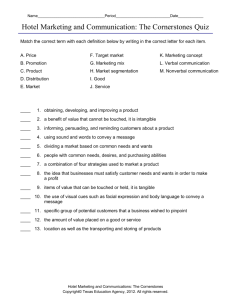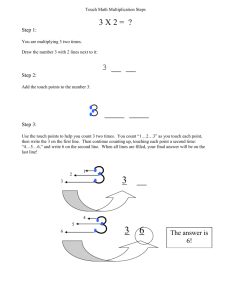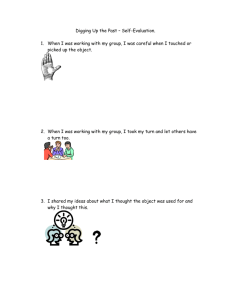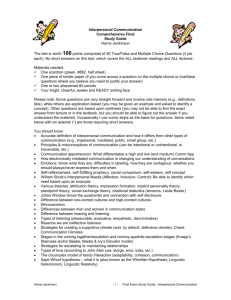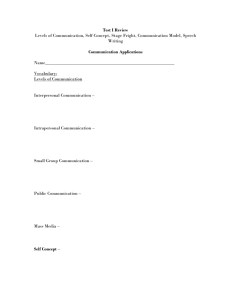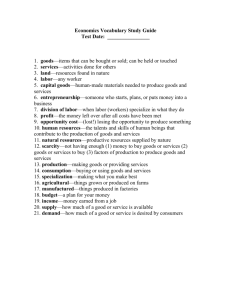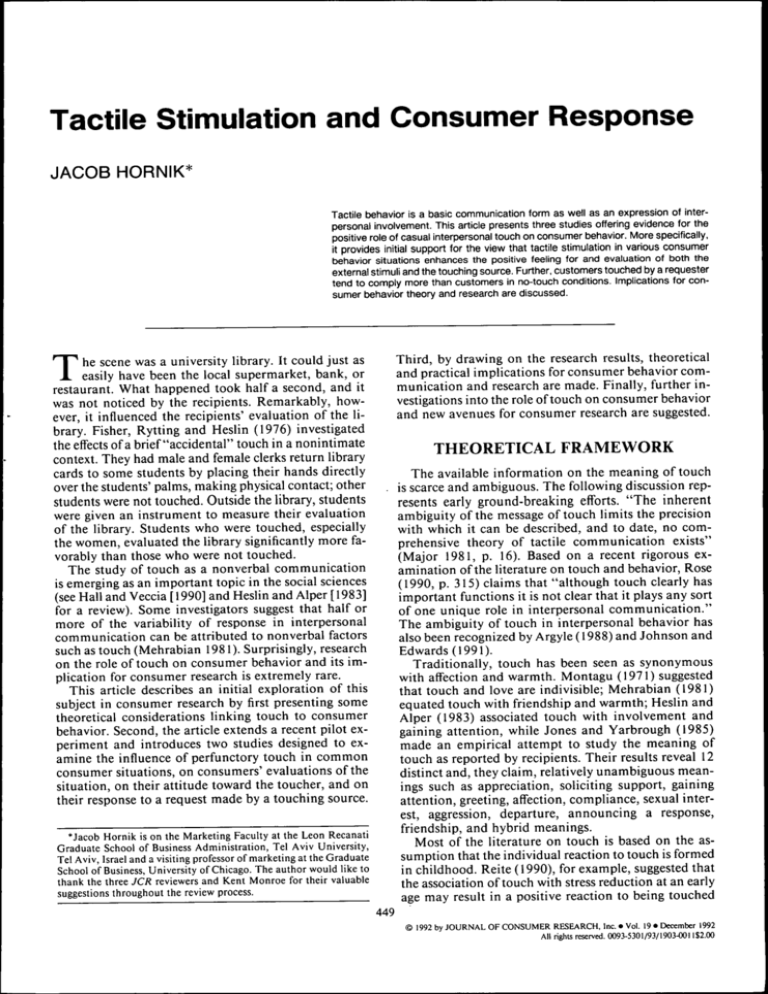
Tactile Stimulation and Consumer Response
JACOB HORNIK*
Tactile behavior is a basic communication form as well as an expression of interpersonal involvement. This articie presents three studies offering evidence for the
positive role of casual interpersonal touch on consumer behavior. iVIore specifically,
it provides initial support for the view that tactile stimulation in various consumer
behavior situations enhances the positive feeling for and evaluation of both the
external stimuli and the touching source. Further, customers touched by a requester
tend to comply more than customers in no-touch conditions. Implications for consumer behavior theory and research are discussed.
Third, by drawing on the research results, theoretical
and practical implications for consumer behavior communication and research are made. Finally, further investigations into the role of touch on consumer behavior
and new avenues for consumer research are suggested.
T
he scene was a university library. It could just as
easily have been the local supermarket, bank, or
restaurant. What happened took half a second, and it
was not noticed by the recipients. Remarkably, however, it influenced the recipients' evaluation of the library. Fisher, Rytting and Heslin (1976) investigated
the effects of a brief "accidental" touch in a nonintimate
context. They had male and female clerks return library
cards to some students by placing their hands directly
over the students' palms, making physical contact; other
students were not touched. Outside the library, students
were given an instrument to measure their evaluation
of the library. Students who were touched, especially
the women, evaluated the library significantly more favorably than those who were not touched.
The study of touch as a nonverbal communication
is emerging as an important topic in the social sciences
(see Hall and Veccia [1990] and Heslin and Alper [1983]
for a review). Some investigators suggest that half or
more of the variability of response in interpersonal
communication can be attributed to nonverbal factors
such as touch (Mehrabian 1981). Surprisingly, research
on the role of touch on consumer behavior and its implication for consumer research is extremely rare.
This article describes an initial exploration of this
subject in consumer research by first presenting some
theoretical considerations linking touch to consumer
behavior. Second, the article extends a recent pilot experiment and introduces two studies designed to examine the influence of perfunctory touch in common
consumer situations, on consumers' evaluations of the
situation, on their attitude toward the toucher, and on
their response to a request made by a touching source.
THEORETICAL FRAMEWORK
The available information on the meaning of touch
is scarce and ambiguous. The following discussion represents early ground-breaking efforts. "The inherent
ambiguity of the message of touch limits the precision
with which it can be described, and to date, no comprehensive theory of tactile communication exists"
(Major 1981, p. 16). Based on a recent rigorous examination of the literature on touch and behavior. Rose
(1990, p. 315) claims that "although touch clearly has
important functions it is not clear that it plays any sort
of one unique role in interpersonal communication."
The ambiguity of touch in interpersonal behavior has
also been recognized by Argyle (1988) and Johnson and
Edwards (1991).
Traditionally, touch has been seen as synonymous
with affection and warmth. Montagu (1971) suggested
that touch and love are indivisible; Mehrabian (1981)
equated touch with friendship and warmth; Heslin and
Alper (1983) associated touch with involvement and
gaining attention, while Jones and Yarbrough (1985)
made an empirical attempt to study the meaning of
touch as reported by recipients. Their results reveal 12
distinct and, they claim, relatively unambiguous meanings such as appreciation, soliciting support, gaining
attention, greeting, affection, compliance, sexual interest, aggression, departure, announcing a response,
friendship, and hybrid meanings.
Most of the literature on touch is based on the assumption that the individual reaction to touch is formed
in childhood. Reite (1990), for example, suggested that
the association of touch with stress reduction at an early
age may result in a positive reaction to being touched
•Jacob Hornik is on the Marketing Faculty at the Leon Recanati
Graduate School of Business Administration, Tel Aviv University,
Tel Aviv, Israel and a visiting professor of marketing at the Graduate
School of Business, University of Chicago. The author would like to
thank the three JCR reviewers and Kent Monroe for their valuable
suggestions throughout the review process.
449
© 1992 by JOURNAL OF CONSUMER RESEARCH, Inc. • Vol. 19 • December 1992
All rights reserved. 0093-5301/93/1903-0011$2.00
450
for most individuals, assuming that the touch and body
areas involved are appropriate for the setting.
The behavioral response to touch will depend on the
touching situation or context as well as on the sex of
the source and/or the recipient. Research has shown
that people are more likely to comply with requests from
touching than from nontouching solicitors when the
solicited response is valid (Willis and Hamm 1980). An
examination of the literature makes it apparent that
touch has different influences on men and women.
Generally, women respond more positively than men
to being touched (Stier and Hall 1984). However, it is
not clear from previous research whether a casual touch
by a male or female stranger also has a stronger positive
influence on females and, if so, under what circumstances.
Touch and Buyer Behavior
Shopping is a frequent personal behavior. However,
many consumers view shopping as a diversion from
daily routines, a means of self-gratification, a source of
sensory stimulation, and a way of socializing. It is well
established in the literature that shopping is a social
experience outside the home that includes social encounters with salespeople. Stone (1954) even argued
that consumers form strong personal attachments to
store employees as a substitute for social contact. Assael
(1987) shows that salespeople's prosocial behavior is an
important source of inspiration for consumers' in-store
behavior.
A salesperson's influence on the customer comes
from many sources of communication, some verbal and
many others nonverbal. It is clear, however, that a
salesperson's success will depend largely on his/her
credibility, friendship, and warmth as perceived by the
customer. It is a familiar experience that words do not
always convey the truth. It is difficult to obtain internal
evidence from the words themselves to indicate whether
the salesperson is telling the truth or not. Nonverbal
signals, on the other hand, are regarded as less controlled
and are commonly perceived by recipients to be more
genuine (Rose 1990). In fact, customers depend on
nonverbal cues for evidence of truth telling.
Although the mechanisms that underscore the relationship between touch and recipients' responses remain unclear, the few explanations available in the literature guide the conceptualizations of the role of touch
on buyers' behavior presented here. Our approach is
based on the theory of relational communication (Parks
1977) and the nonverbal communication models within
the theory. Relational communication analysis begins
with the idea that nonverbal communication contains
both an appeal or relational component and an interpersonal bond component. The theory stems from the
fundamental observation that nonverbal communication, such as touch, during a request encounter will result in more social influence as a result of an increase
JOURNAL OF CONSUMER RESEARCH
in attentional arousal and perceived interpersonal intimacy.
Drawing from the theory of relational communication and the empirical literature on the role of touch
in interpersonal communication, three general (and interrelated) effects on consumer behavior are suggested.
First, in the right context, nonreciprocal touch should
make consumers feel more positive about the situation
surrounding the touching events. The mechanisms underlying this link were advanced by some investigators
(e.g., Patterson, Powell, and Lenihan 1986) who showed
that touch enhances one's general positive feelings and
mood and increases attentional arousal, which subsequently influences one's evaluation of the external
stimuli surrounding the touch situation. Therefore, in
the shopping context in which customers seek social
support and affection, proper touch will produce overall
positive feelings toward the store.
Second, touch can affect the way the toucher is perceived by recipients. Individuals associated with the
human potential movement (encounter groups, etc.)
have long maintained that touching leads to a person
liking the toucher. Limited research suggests that touch
plays an important role in shaping the image of the
toucher and in enhancing interpersonal involvement.
It has been shown, for example, that counselors who
touch clients are more positively perceived than those
who do not. They are also judged to be more emphatic
(Pattison 1973). Others have suggested that touching
another person during a social encounter may increase
the recipient's feelings of social attachment, intimacy,
and, therefore, liking (Mehrabian 1981). More recently,
Patterson et al. (1986) have argued that people tend to
attribute a multitude of positive characteristics to the
toucher and are willing to exercise certain positive behaviors toward that person. The above conceptualization can be used to underscore the role of touch on
customers' perceptions of the touching server. Tactile
stimulations will produce a feeling of social attachment
and personal involvement while also facilitating customers' perceptions of salespeople's trustworthiness and
warmth, which will enhance their liking.
Finally, touch may play an important role in persuasion. The limited literature on this topic would suggest that consumers will comply more readily with a
request made in conjunction with an interpersonal
touch. Kleinke (1977) found that subjects returned a
dime left in a phone booth significantly more often to
the "telephone caller" who touched them than to the
caller who did not. Similarly, Hornik and Ellis (1988)
showed that touched individuals were more likely to
agree to participate in mall intercept interviews. On the
basis of these studies Rose (1990) maintains that the
recipient tends to assume that the toucher is in genuine
need and that the toucher likes and trusts him. The
perception of either a great need or a positive feeling
tends to increase compliance.
TACTILE STIMULATION AND CONSUMER RESPONSE
Perhaps the most basic meaning of touch in the buying setting is that an interpersonal bond is being offered
or established by the server. Like other verbal and nonverbal communication, touch seems to strengthen other
messages. The assertive component of touch might also
influence the recipient. In short, we propose the following mechanism: touch exerts influence on customers'
behavior by enhancing liking of the salesperson and by
creating higher emotional involvement with the shopping situation. In addition, a touched customer might
be more inclined to comply or help the server because
touch increases feelings of^ intimacy and closeness to
the touching source.
Summary
The preceding conceptualization and some of the
empirical evidence suggest several interesting relationships between tactile stimulation and buyer behavior.
Specifically, it is posited that in-store touch will enhance
customers' positive attitudes toward the store and the
server and encourage shopping behavior.
The studies presented here were designed to assess
the effect of touch on consumers' responses in legitimate
daily and common purchasing situations: first, on customers' evaluations of a store (the external stimuli);
second, on the customers' evaluations of the server (the
touching source); and third, on the willingness of the
recipient to comply with a request. Actually, the two
later investigations were prompted by the results of the
first pilot study, which alluded to the potential effects
of touch on consumers' behavior.
Most research on the influence of nonverbal communication like touch tends to be laboratory studies in
contrived situations. More recently, there has been a
growing concern for the fact that laboratory studies and
the results they produce may have little to say about
how touch actually influences behavior in natural settings. This problem has led researchers to suggest that
rigorously designed experiments be carried out in more
realistic field settings. (For a comprehensive review on
this issue, see Scherer and Ekman [1982].) Therefore,
all three studies reported here were conducted in the
field in genuine buying or consumption situations. In
addition, an attempt was made, wherever possible, to
compare the influence of the source on male and female
customers using cross-sex and same-sex interactions.
METHODS
Overview
The overall design and most of the basic methods
employed were purposely retained in the three studies.
Specifically, all experimental groups were touched and
compared to (no-touch) control groups. Second, all
three studies were conducted in realistic field settings
where customers were touched during genuine purchasing situations. These situations were chosen because
451
they facilitated proper experimental manipulations and
control over the actions of the experimenters. They also
provided good methods for assessing qualitative and
quantitative behavioral responses. Third, because of the
complexity of the study procedures and the experimental manipulations, particular emphasis was placed on
experimenter training and control. To ensure that all
experimenters used the same touching method, maintained a normal body posture, and followed the specified
sampling procedures and recording methods, each experimenter completed at least one rigorous training
session as well as a pretest procedure.
Specifically, before conducting the experiment, experimenters practiced with role-playing subjects.
Professional observers recorded their behavior during
the practice and pretest sessions to ensure that it would
be possible to manipulate the experimental treatments
in a consistent manner. These treatments included
touching the subject on the arm or shoulder and maintaining a normal approach throughout the interaction.
The alternative behavior was a control no-touch condition: experimenters were instructed and trained to
maintain normal behavior without touching. Experimenters in both the touch and no-touch conditions were
at all times pleasant and friendly to customers. They
smiled during each approach and maintained a constant
interaction distance. All these types of training procedures and touching manipulations have been shown in
previous research to be reliable and effective (e.g.,
Kleinke 1980; Major, Schmidlin, and Williams 1990;
Stier and Hall 1984).
Because of concern for possible distortions in the
field, rigorous measures of control were also administered during the experiment. Each experimenter was
accompanied by a member of the research team, who
supervised and recorded the entire procedure from a
distance. It should be noted that, in addition to reporting the experimenter's performance, each observer
was asked to report any unusual subject reactions, such
as interaction break-offs or evidence of restlessness or
discomfort. Also, between-experimenters tests were
conducted within each experimental condition to reveal
possible experimenter effect beyond the designed manipulation. Those experimenters who felt severely uncomfortable with the methodology were allowed to drop
out of the experiments.
The methods and results of the three studies will be
presented below, together with a brief discussion of
conclusions reached through the analysis of the predicted effects. A total of 206 subjects participated in
study 1, and 248 and 217 subjects completed studies 2
and 3, respectively. According to statistical power tables
prepared by Cohen (1987), these sample sizes should
be adequate to test medium effect sizes (ES) at the .05
level of significance with a power in the range of .90.95. These conditions also adhere to the standards described by Sawyer and Ball (1981) in their discussion
of statistical power in marketing and consumer behavior
452
JOURNAL OF CONSUMER RESEARCH
research. Obviously, the methods and procedures of all
three studies were not identical. The differences are
noted below for each study.
STUDY 1
The first study was part of a comprehensive project
investigating patterns of shopping-time behavior. An
attempt was made to use this opportunity to explore
whether touch would significantly affect subjects' shopping times and store evaluations. As noted before, the
result of this pilot study prompted us to further investigate possible touch effects on consumer behavior. Our
results have been described in detail in a companion
note (Hornik 1992). To review briefly, 286 shoppers
were approached by three male and three female experimenters as they entered a large bookstore. As a lone
shopper entered the store, he/she was greeted by an experimenter who handed him/her a four-page catalog
specifying items, prices, discounts, credit, etc. During
alternate one-hour periods, the experimenter either
touched the subject lightly on the upper arm or did not.
At the end of the shopping trip, all shoppers had to
proceed to the cash register to stamp their parking coupon for exit time. The experimental subjects were approached by interviewers, who recorded their shopping
time and the amount on the sales slip and asked each
shopper to fill out a brief store-evaluation card, which
entitled him/her to participate in a drawing.
Three measures were used to evaluate the influence
of touch on shoppers' behavior: shopping time, store
evaluation, and amount of purchase. Three ANOVAs
were performed for each measure to analyze the results
of the 2 (touch vs. no touch) X 2 (experimenter's sex)
X 2 (subject's sex) factorial design. These analyses revealed a positive main effect caused by touch for all
dependent measures. The influence on mean shopping
time (22.11 minutes for the touch group and 13.56
minutes for the no-touch group) was significant
{F{ 1,245) = 8.27, ;7 < .01, r = . 18).' Touched shoppers
responded more favorably toward the store (X = 3.2 vs.
X = 2.1,/-(1,241) = 3.92,/7<.05, r = . 18) and purchased
more than no-touch subjects ($15.03 vs. $12.23,
F{ 1,245) = 4.86, p < .05, r = . 14). Analysis by subjects'
gender showed that touch was more influential on female shoppers than on male shoppers but affected only
one dependent measure—shopping time (f(l,115)
= 3.18,p<.08,/•= .16).2
The pilot study results supported the predicted effect
of touch not only on shopping time but also on the way
'The following formula was used, throughout the paper, to calculate
the magnitude of all experimental effects (effect size):
r = (eta) =
+ (rf/error) '
Rosenthal and Rosnow (1984, p. 356).
^Effect size measure led me to not dismiss this interaction effect as
insignificant and unworthy of further attention.
consumers evaluated the store, as well as the effect on
their purchasing behavior. These results originated the
propositions of studies 2 and 3: touch might influence
consumers' perceptions of the toucher and facilitate
higher compliance, respectively.
STUDY 2
The second study was designed to investigate the influence of touch on customers' evaluations of the
toucher during a consumption activity. This was operationalized using a common expression of appreciation to a server—tipping (Lynn and Grassman 1990).
Crusco and Wetzel (1984) studied the effect of touching on the tipping behavior of single customers. This
experiment is not only a replication but also a significant
extension of their study. First, the current experiment
investigated a possible server-customer gender interaction effect. Second, as suggested by others (e.g., Caballero and Pride 1984), this study looked into the possible influence of server attractiveness on customers'
behavior. Third, this study focused on the reaction to
touch by mixed couples. An attempt was made to compare the results to those of Crusco and Wetzel's (1984)
study by focusing on the effect of touch, by a waiter or
waitress, on the customer in the presence of a companion of the opposite sex.^ Fourth, this study contains
additional dependent variables to measure the customers' evaluations of the servers.
Experimenters
The experimenters were four part-time waiters and
four part-time waitresses employed by a large restaurant. They were selected from a pool of 27 servers on
the basis of their physical attractiveness, following a
pretest on this factor.
Physical attractiveness has been an important topic
of research in the social sciences. There is ample evidence to suggest that an attractive person may be more
effective in the interpersonal context of selling than an
unattractive one (Caballero and Pride 1984). The results
of studies showing that a physically attractive person
facilitates behavior and engenders a higher rate of compliance have been interpreted using various theoretical
explanations such as social adaptation theory (Kahle
and Homer 1985)."
A two-stage procedure was used here to select the
eight experimenters, four of whom (two waiters and
two waitresses) were scored as highly attractive and four
of whom (two waiters and two waitresses) were scored
low. First, two weeks prior to the study, a group of cus•'The decision to investigate mixed-couple customers was also
prompted by the fact that most customers dining at the restaurant
being studied were mixed couples.
•"A comprehensive review on this topic can be found in Beney
(1987); Debono and Teleca (1990).
453
TACTILE STIMULATION AND CONSUMER RESPONSE
tomers were asked to rate various attributes of the restaurant, including the physical attractiveness of its
servers. The procedure and measure were adopted from
Simpson, Lerma, and Gangestad (1990). Specifically,
the measure was a seven-point scale, with seven representing high attractiveness. Twelve servers (six male
and six female) were selected for the attractiveness
treatment.^ The second stage was a pretest of the experimental conditions. The servers selected as experimenters were those who scored high/low on attractiveness and who also received a high evaluation by the
trainers on the way they conducted the experimental
manipulations. Experimenters were not informed of the
experimental hypotheses. Each was asked to approach
approximately the same number of randomly assigned
subjects.
Subjects and Design
A total of 248 mixed-couple diners participated in
the second experiment. Subjects were assigned randomly to each cell in a 2 (touch vs. no touch) X 2 (server's gender) X 2 (high vs. low on attractiveness server)
X 2 (customer's gender) design.
Dependent Measures
Two measures were employed in this study to evaluate the influence of touch on consumers' evaluations
and reactions toward the servers. First and most important, an objective measure of customer appreciation
of server was obtained. Following Lynn and Grassman's
(1990) study confirming the expectation that customers
give tips to convey their appreciation and to buy social
approval and equitable relationships, tip size as a percentage of the bill was taken as the measure of appreciation.*
The second dependent variable was a general evaluation of the server obtained from subject response to
a nine-point bipolar semantic differential scale. A similar scale was used for the third dependent variable,
which aimed to assess overall attitude toward the restaurant. These last two responses were obtained by interviewers stationed near the restaurant exit as part of
a routine survey conducted during the previous weeks.
Five pairs, two from the touch and three from the notouch condition, declined to complete the form. They
were therefore used only for the first dependent measure.
Procedure
All experimenters went through thorough training
sessions as described previously. The experiments were
'The experimenters selected received a high interjudge reliability
score. The correlation coefficient obtained for ratings by males vs.
by females on all 12 was .87.
^Although the person touched was recorded, obviously, no data
could be obtained on who actually made the tip decision.
TABLE 1
MEANS (SD) OF MALE AND FEMALE DINERS' TIPPING AND
EVALUATION OF SERVERS AND EVALUATION OF
RESTAURANT BY TOUCHING CONDITIONS AND
SERVERS' SEX AND ATTRACTIVENESS
Tipping
Experimenters"
Male (HA);
Touch
No touch
Male (LA):
Touch
No touch
Female (HA):
Touch
No touch
Female (LA):
Touch
No touch
Total:
Touch
No touch
Evaluation of
server*
Evaluation of
restaurant"
Male
Female
Male
Female
Male
Female
16.35
(6.49)
14.41
(5.13)
17.96
(8.23)
14.51
(6.12)
3.27
(1.21)
2.42
(.86)
3.49
(1.27)
2.48
(.85)
2.78
(1.07)
2.13
(.79)
2.98
(1.12)
2.17
(.81)
16.04
(6.20)
14.07
(4.78)
16.21
2.88
(8.11) (1.03)
14.12
1.83
(.77)
(5.84)
2.94
(1.14)
1.93
(.80)
2.55
(.91)
2.07
(.77)
2.73
(1.03)
2.11
(.79)
16.92
(6.70)
14.67
(5.27)
19.82
(8.61)
15.25
(6.37)
3.31
(1.09)
2.54
(.89)
3.53
(1.38)
2.57
(.97)
2.81
(1.06)
2.46
(.95)
3.04
(1.09)
2.31
(.88)
16.63
(6.71)
14.52
(4.87)
16.39
(8.29)
14.27
(5.97)
2.79
(.90)
1.82
(.76)
2.69
(1.02)
1.95
(.81)
2.60
(.92)
2.11
(.77)
2.72
(.96)
2.14
(78)
16.51
(6.49)
14.49
(5.17)
3.07
18.84
(8.21) (1.08)
14.51
2.20
(6.18)
(.91)
3.25
(1.13)
2.27
(.82)
2.69
(1.03)
2.14
(.84)
2.84
(1.10)
2.21
(.82)
'HA = high attractive, LA = low attractive.
"Extremely good (+4), neutral (0), extremely poor (-4).
"Superior restaurant (+4). neutral (0), inferior restaurant (-4).
conducted during evening hours over five weekdays. In
half the cases the server touched either the male or female subject on the arm for one second toward the end
of the meal while asking if everything was all right.
Results of Study 2
Table 1 contains the means for all experimental cells,
while Table 2 reports all significant results obtained by
the ANOVA for each of the three dependent measures.
Rate of Tipping. The highest average tip (19.82
percent) was obtained from the female diners in the
touched condition served by an attractive waitress. The
lowest average tip (14.07 percent) was from male diners
in the no-touch condition served by a waiter rated low
on attractiveness. This figure was close to the average
normal tip of 13.8 percent for mixed pairs in this restaurant. The mean scores also show that touched male
diners tipped on the average 2 percent more than notouch males, whereas the mean differences between
touched and no-touch females is much higher—over 4
percent.
454
JOURNAL OF CONSUMER RESEARCH
TABLE 2
SUMMARY OF ANOVAS FOR RESPONSE MEASURES: STUDY 2
Evaluation of
server
Percent tipping
Evaluation of
restaurant
Source
df
SS
F
SS
F
SS
F
Touch (T)
Server gender (S)
Customer gender (C)
Server attractiveness (A)
TXC
TX A
TXC X A
1
1
1
1
1
1
2
8.7
2.1
3.2
2.9
6.3
3.4
5.8
6.4"
1.4
4.0*
3.7*
4.1*
2.1
3.4+
9.8
2.8
2.6
2.4
7.4
5.0
4.2
7.6**
1.9
2.1
1.9
4.4*
4.1*
2.4
6.1
1.2
.9
.3
4.7
2.8
2.2
4.3*
.6
.4
.5
3.3+
1.9
2.3
NOTE.—SS = sum of squares.
*p<.1.
*p < .05.
"p < .01.
The ANOVAs reveal a significant main effect for
touching on tipping (/='( 1,214) = 6.4, ;7 < .01, r = . 17).
In addition, customer's gender and server's physical attractiveness are also statistically significant (f(l,214)
= 4.0,p < .05, r = .14; f(l,214) = 3.7,/? < .05, r = .13,
respectively). The only main effect not found to significantly influence customer tipping was the server's gender. Table 2 also shows that, among the interactions,
the following were found significant on tipping: touch
by customer gender (7^(1,98) = 4.1, /? < .05, r = .20)
and the three-way interaction of touch by customer's
gender and server's attractiveness (F(2,98) = 3.4, p
< .01, r = .25). No other significant interaction effects
were revealed in the data for the tipping measure.
Independent F-tests show that servers who touched
the female diner of the pair received more appreciation
than those touching the male diner. This result is especially apparent when the touching server is an attractive waitress (F(l,58) = 3.91, p < .05, r = .25).
Evaluation of the Server. In accordance with the
study predictions, the mean scores shown in Table 1
clearly reveal that touch produced higher evaluation
scores of servers by both male and female diners. The
highest average score was obtained from female customers touched by an attractive waitress (3.53). The
lowest average score (1.82) was obtained from male
subjects served, but not touched, by unattractive female
servers.
The ANOVAs shown in Table 2 yielded a main effect
for touch (F(l,211) = 7.6, ;?<.01, r = . 19), with servers
in the high attractiveness conditions obtaining the
highest evaluations. As with the tipping measure, the
servers' gender did not produce significant differences
in the way they were evaluated. Two significant interaction results were obtained from the data: first, touch
by customer gender and second, touch by server's attractiveness (F(l,92) = 4.4, p < .05, r = .21; F(l,92)
= 4.1, ;7 < .05, r = .21, respectively). A separate F-test
showed that servers who touched the female customer
received significantly higher evaluation scores than
those touching the male diner (F(l,113) = 5.15, p
< .01, r= .21).
Evaluation of Restaurant. Mean restaurant evaluation scores and ANOVA results are also shown in Tables 1 and 2. The mean scores show an obvious improvement in restaurant evaluation by both male and
female customers who were touched by servers. As in
the previous two cases the highest mean evaluation was
obtained from female diners touched and served by an
attractive waitress (3.04). The lowest score was obtained
for male customers served by a nontouching and less
attractive waiter (2.07).
The ANOVA results reveal a significant main effect
for touching on restaurant evaluations (/"(1,211) = 4.3,
p < .05, r = .14). Notable among the interactions is the
significant {F{ 1,92) = 3.3, p < . 1, r = . 19) influence of
touch by customer gender. However, neither the gender
of the touched diner nor the gender or attractiveness of
the touching server seem to affect the way customers
evaluated the restaurant. A comparison of the evaluations between the no-touch experimental subjects and
prestudy diners revealed that averages of restaurant ratings were very close.
Overall, the results of study 2 reveal that a casual
touch by a waiter or waitress might be an important
positive factor in the way mixed-couple diners will tip
and evaluate the server and might also enhance the way
the couples evaluate the restaurant.
It should also be noted that in order to check for
possible unusual behavior of experimenters and subjects, two estimates were obtained. First, the written
and oral notes of the observers on experimenters' and
subjects' conduct were analyzed. Second, postexperimental sessions with experimenters on their own and
others' behavior during the experiments were also recorded. No evidence was found that the effects could
455
TACTILE STIMULATION AND CONSUMER RESPONSE
be attributed to rival explanations that were not included in the experimental manipulations.
STUDY 3
The third experiment intended to evaluate whether
touch facilitates higher customer compliance to a marketing request. Specifically, the study was designed to
test shoppers' reactions to a product demonstrator who
touched them while asking them to sample and buy the
new product. As in the previous two studies, the third
experiment was conducted in a field setting, which provided more genuine consumer responses as dependent
measures.
Stimulus and Procedure
Lone adult shoppers in a supermarket were approached by four trained female demonstrators who
were unaware of the study's objectives.^ The demonstrators (experimenters) were selected from a pool of
part-time employees who performed best in the training
sessions. They were dressed in company uniforms bearing the company's name and logo, which were also displayed on the exhibition counter.
The demonstrators, positioned in a location within
the supermarket frequently used for new product demonstrations and sampling, intercepted shoppers as they
passed the exhibition counter and asked them to taste
a new snack. During the alternate one-hour periods,
the demonstrators either touched the subjects lightly
on the upper arm while making the request or did not
touch them. They were asked to approach an equal
number of male and female shoppers in each experimental condition. Whether the shopper agreed or declined to taste the product, s/he was given a discount
coupon to be redeemed at the cash counter and was
shown the location of the product. No further interaction between the subject and the demonstrator took
place.
An observer recorded the subjects' gender, the touch
condition, approximate ages, and whether they tasted
the product or rejected the offer. As in the two previous
studies, observers who were fully aware of the study
objectives were asked to report the demonstrators' conduct as well as any unexpected behavior on the part of
the shoppers.
Results of Study 3
Observers' reports and study results were first analyzed to check f^or possible rival explanations and between-demonstrators effect on the dependent variables.
Specifically, the professional observers' written and oral
'No male demonstrators were available. We considered using male
students instead but decided to use only the experienced female demonstrators, in order to maintain a genuine shopping situation.
TABLE 3
SHOPPERS' RATE OF COMPLIANCE TO A TASTING AND
PURCHASING REOUEST, BY TOUCH CONDITIONS
AND SUBJECTS' GENDER
zSubjects
Tasted:
Male(n = 106)
Female (n = 111)
Total
Purchased:
Male
Female
Total
Touch
No touch
Value"
P
45/58 = 77.6
54/59 = 91.5
99/117 = 84.6
29/48 = 60.4
36/52 = 69.2
65/100 = 65.0
1.92
3.03
3.37
.03
.001
.0001
33/58 = 56.9
42/59 = 71.2
75/117 = 64.1
19/48 = 39.6
24/52 = 46.2
43/100 = 43.0
1.81
2.76
3.17
.03
.003
.001
•All significance tests based on normal approximation to z and one-tailed
distributions:
P,
VP(1 -
reports were thoroughly discussed to reveal any possible
rival explanation. This analysis showed that the touch
manipulation seemed to be the only independent factor
in this study. Also, experimental results by demonstrators did not show significant differences between demonstrators and group results. Thus, homogeneity of experimenters and procedure was assumed.
To evaluate compliance, two dependent variables
were used.* The first was the subjects' willingness to
taste the product, as obtained from observers' records.
The second was the subjects' actual purchasing behavior, using redeemed coupons as the purchasing measure.
The touch manipulations combined with subject's
sex resulted in a 2 (^touch vs. no touch) X 2 (subject's
gender) design. Table 3 contains the number of male
and female shoppers who complied and who failed to
comply with the tasting and purchasing requests in relation to the touch condition.
A standard test for significance of differences in proportions was employed, using the normal approximation to the appropriate z transforms (Guilford and
Fruchter 1973). Statistical significance was calculated
on a one-tail basis, since the theoretical base for the
study specified the direction for anticipated differences.
A review of Table 3 leads to the following conclusions.
Taste Request. The overall percentage of touched
subjects who complied with the taste request was 84.6
percent, whereas only 65 percent of the no-touch (control) shoppers agreed to the taste appeal by demonstrators. The difference between the two is significant (z
= 3.31, p < .0001). The rate of product sampling shows
considerable variation between treatments, ranging
*A third dependent variable had been initially designed for this
study—store evaluation. It had to be dropped, however, at the last
minute, due to a misunderstanding between the store manager and
chain headquarters.
456
JOURNAL OF CONSUMER RESEARCH
from a high of 91.5 percent for touched female shoppers
to a low of 60.4 percent for no-touch male shoppers.
Table 3 reveals significant differences between the
touch conditions for both male and female shoppers {p
= .02 and/7 = .001, respectively). The rates of compliance between male and female shoppers were also compared. While no significatit differetices were obtaitied
for gender effects in the no-touch condition on the taste
measure (z = .92, p > A), significant differences were
revealed between touched male and female shoppers (z
= 2.13,p< .01).
Although the practice sessions, as well as the observers' reports, indicate that the treatments were administered in an unbiased fashion, future research might
attempt to impose a stricter test for possible bias. For
example, researchers may incorporate expectancy control groups in which experimenters are given different
explanations of the experiments (Rosenthal and Rosnow 1984).
Purchase Request. As predicted, the number of
overall coupons redeemed by the treatment (touched)
group was significantly greater than for the control (notouch) group {p < .001). Significant differences were
also found between the touch and no-touch conditions
for both male and female shoppers. The highest purchasing group was touched female (71.2 percent), while
the lowest was no-touch male (39.6 percent). Finally,
touch was more influential on female shoppers than
male shoppers (z = 1.63, p = .05), while no significant
differences were revealed between the two sexes in the
control group ( p > .1).
A chi-square analysis was also performed on the data.
The results confirmed those in Table 3. Specifically, the
taste and purchase rates in the different experimental
conditions were compared with the compliance rates
in the control (no-touch) conditions. As anticipated,
the taste and purchase rates for the treatment groups
were significantly greater than for the control groups
ix\2) = 25.38, p < .01; and xH2) = 21.78, p < .01,
respectively).
The data of the third experiment were in accord with
the study's predictions: touched customers complied
more with the experimenters' requests than did notouch customers. These results were especially apparent
for touched female shoppers.
Subject to these limitations, the results of the three
studies are encouraging. They constitute a contribution
to the growing empirical evidence in the social sciences
of the positive influence of interpersonal casual touch
on recipient response. Touch connotes many meanings
such as closeness, warmth, being cared for, contact, and
affection—for the most part comforting feelings. This
connection with closeness—the establishment of social
attachment—has been popularized by one major corporation with the slogan "Reach out—reach out and
touch someone."
The results of the studies presented here offer empirical support for the relationship of touch and three
general dependent variables that are of considerable interest to consumer researchers. They demonstrate that
touch has a positive influence on consumers' evaluations of the external stimuli surrounding the touching
situation, that it contributes to the customers' positive
regard for the server, and that it facilitates buyers' compliance with a request. As such, the meaning of the results is clear: a consumer's response can be influenced
by touch.
The data revealed some interesting interactions, especially between touch and customer's gender (studies
2 and 3). These interactions indicate that differences in
compliance rates are linked to the sex of the customer.
Although significant server-gender effects (in studies 1
and 2) are not large, systematic differences as a function
of server attractiveness were revealed in study 2, particularly for female customers. The issue of differences
in reaction to touch by the recipient's gender is not
conclusive. As in other studies (e.g., Stier and Hall
1984), part of the current research (studies 2 and 3)
provides evidence that touch has more of an effect on
female recipients. However, the first study failed to
provide conclusive results on this point, raising the
question of whether and under what conditions the
gender of the recipient might produce a different response to touch.
Comparing the findings among the three current experiments with other studies (e.g., Johnson and Edwards
1991) suggests the tentative explanation that, when the
response immediately follows the touch, female recipients tend to respond more than males. The more the
expected response is delayed, the less apparent is the
effect on females and the greater the similarity of their
behavior to that of male recipients. It is proposed that
LIMITATIONS
As with any controlled studies, the current experiments necessarily imply some compromise of external
validity for the sake of increased measurement control.
Therefore, the mode of stimuli, the type of respondents,
experimenters, and instruments might have affected the
magnitude or even the directions of the reported results.
Hence, the possibility always exists that different consumer settings, different experimenters, or different
measurement techniques could have resulted in somewhat different findings. Replications to assess these and
other questions concerning validity must await further
research. For example, study 2 showed the role of server
attractiveness on recipients' responses. Thus, one cannot completely rule out the influence of this factor on
the findings in studies 1 and 3. Future researchers, utilizing touch as an independent variable, would be advised to control for the attractiveness of the touching
source during experimental manipulations.
CONCLUSIONS
457
TACTILE STIMULATION AND CONSUMER RESPONSE
these gender differences in reactions to touch possibly
reflect a tendency among women to seek more affection,
warmth, and interpersonal intimacy in their social relationships than do men (Hall and Veccia 1990). Also,
women tend to be more submissive than men (Rose
1990). It is possible, therefore, that immediate reaction
to touch is one way for women to express their appreciation for any signs of affection and interpersonal
intimacy and is an expression of their behavioral
submissiveness. These suggestions, however, deserve
further scrutiny in research on the effects of touch.
There is more to touch than "meets the hands." Because of the ambiguity of touch and the variety of cognitive responses to touch discussed in the literature, it
cannot be claimed that the three studies reported here
confirm all the underlying mechanisms offered in the
theoretical sections. Further investigations should include more direct assessments and measurements of
variables suggested to mediate consumers' reactions to
touch. For example, how does touch, in a shopping setting, facilitates positive moods, increase attentional
arousal, and enhance the feelings that an interpersonal
bond was offered or established? Attempting to link all
these mediators to different consumers' responses are
questions for future research.
Because persuasion can be enhanced by deliberate
touch, its use is of ethical as well as practical concern.
Although it is a common practice in marketing to manipulate consumers to secure compliance, the ethics of
the method is of paramount importance—particularly
in terms of unethical applications of certain modes of
touch. The issue is one of degree. Therefore, only reasonable tactile stimulation of consumers should be used
and/or one should rely on other less sensitive persuasion
techniques.
Future Research
Besides addressing the methodological issues discussed in the limitations section, future research should
explore several areas of interest to the field of consumer
research. Nonverbal communication is ubiquitous. It
is used simultaneously with much of the verbal communication through body language, gestures, facial
expressions, and physical touch. Like other nonverbal
behavior, touching may support or contradict communication by others. A serviceperson may explain to
customers that they do not need to worry about their
dryer, and his or her touch may add confirmation, but
it may contradict the verbalization if the serviceperson
appears restless, still, or abrupt. Thus, the study of nonverbal components of behavior appears to offer a rich
field for researchers interested in identifying the ways
in which nonverbal communications, like touch, complement and structure the verbal interaction process in
different consumption situations. The results should
provide new ways to increase the understanding and
effectiveness of various interpersonal communications.
Tactile stimulation in interpersonal transactions and
service delivery has been virtually ignored by consumer
behavior researchers. Future research might take a step
toward integrating research on touch with the long tradition of research on consumer satisfaction (e.g., Oliver
and Swan 1989). Similarly, greater attention should be
directed to investigating possible cognitive and emotional reactions of consumers to touch and to the
toucher.
More research is needed into contextual factors pertaining to touch in consumer behavior. Given the inherent ambiguity of touch, the context in which it occurs
may be an important determinant of consumers' reactions. Future research should reflect situations that
are encountered frequently in consumer behavior, like
physical surroundings (at home, in a bank, in a bar),
social surroundings (presence of other people), and antecedent states (mood).
The effect of server attractiveness was studied here
in the one case where data could be obtained. It is clear
that research on touch and consumer behavior requires
greater familiarity with the attractiveness factor as well
as other moderating variables that might exert influence
on recipients' responses to touch. These might include
such variables as race, age, and the social status of the
interactants.
Some research on touch demonstrates that people
who touch are seen as warm and caring by observers.
For example, Kleinke, Meeker, and La Fong (1974) exposed college students to videotapes of couples who either touched or did not touch during the taped interaction. Touching couples were seen as significantly
closer, more attentive to each other, and more relaxed
than nontouching couples. It might be interesting to
investigate the meaning consumers extract from observing other people touching, for example, in various
television commercials. Also, it might be worthwhile
to expand study 2 to include measures that will investigate the influence of touch on the individual's reactions while observing his/her spouse being touched.
Finally, it is suggested that the research paradigms
employed in the present studies be extended beyond
the subject of tactile communication to apply to the
wide variety of nonverbal communication modes.
In conclusion, we believe that the role of touch in
consumer behavior is more important than the present
state of the art in consumer research would seem to
indicate. There is even some evidence to suggest that it
may be more important than verbal communication
(Stewart, Hecker, and Graham 1987). It is certainly not
less important. Therefore, further testing should be undertaken in order to provide a more comprehensive
theoretical foundation and practical guidance in diverse
consumer behavior situations.
[Received June 1991. Revised April 1992.]
458
JOURNAL OF CONSUMER RESEARCH
REFERENCES
Argyle, Michael (1988), Bodily Communication, Madison,
WI: International Universities Press.
Assael, Henry (1987), Consumer Behavior and Marketing Actions. Boston: Kent.
Beney, Joseph W. (1987), "Tfie Credibility of Physically Attractive Communication: A Review," Journal of Advertising, 11 (3), 15-24.
Caballero, Marjorie J. and William M. Pride (1984), "Selected
Effects of Salesperson Sex and Attractiveness in Direct
Mail Advertising," Journal of Marketing, 48 (January),
94-100.
Cohen, Jacob (1987), Statistical Power Analysis for the Behavioral Sciences, Hillsdale, NJ: Erlbaum.
Crusco, April H. and Christopher G. Wetzel (1984), "The
Midas Touch: The Effects of Interpersonal Touch on
Restaurant Tipping," Personality and Social Psychology
Bulletin, 10 (December), 512-517.
Debono, Kenneth G. and Christine Teleca (1990), "The Influence of Source Physical Attractiveness on Advertising
Effectiveness—a Functional Perspective," Journal of
Applied Social Psychology, 20 (17), 1383-1395.
Fisher, Jeffrey D., Marvin Rytting, and Richard Heslin (1976),
"Hands Touching Hands: Affective and Evaluative Effects of an Interpersonal Touch," Sociometry, 39 (3),
416-421.
Guilford, John P. and Benjamin Fruchter (1973), Fundamental Statistics in Psychology, New York: McGraw-Hill.
Hall, Judith D. and Ellen M. Veccia (1990), "More Touching
Observations—New Insights on Men, Women, and Interpersonal Touch," Journal of Personality and Social
Psychology, 59 (6), 1155-1162.
Heslin, Richard and Aari Alper (1983), "Touch—a Bonding
Gesture," in Nonverbal Interaction, ed. John M. Weimann and Randall P. Harrison, Beverly Hills, CA: Sage,
47-75.
Hornik, Jacob (1992), "Effects of Physical Contact on Customers' Shopping Time and Behavior," Marketing Letters, 3 (January), 49-56.
and Shmuel Ellis (1988), "Strategies to Secure Compliance for a Mall Intercept Interview," Public Opinion
Quarterly, 52(4), 539-551.
Johnson, Kevin L. and Renee Edwards (1991), "The Effects
of Gender and Type of Romantic Touch on Perceptions
of Relational Commitment," Journal of Nonverbal Behavior, 15(0,43-55.
Jones, Stanley E. and Elaine Yarbrough (1985), "A Naturalistic Study of the Meanings of Touch," Communication
Monographs, 25 (March), 19-56.
Kahle, Lynn R. and Pamela M. Homer (1985), "Physical Attractiveness of the Celebrity Endorser: A Social Adaptation Perspective," Journal of Consumer Research, 11
(March), 954-961.
Kleinke, Chris L. (1977), "Compliance to Requests Made by
Touching Experimenters in Field Settings," Journal of
Experimental Social Psychology, 13 (2), 218-223.
(1980), "Interaction between Gaze and Legitimacy
of Request on Compliance in a Field Setting," Journal
of Nonverbal Behavior, 5 (1), 3-12.
, Frank G. Meeker, and C. La Fong (1974), "Effect of
Gaze, Touch, and Use of Name on Evaluation of Engaged
Couples," Journal ofResearch in Personality, 1 (3), 368373.
Lynn, Michael and Andrea Grassman (1990), "Restaurant
Tipping: An Examination of Three Rational Explanations," Jour«a/o/£co«om/c ftyc/io/o^y, 11 (1), 169181.
Major, Brenda (1981), "Gender Patterns in Touching Behavior," in Gender and Nonverbal Behavior, ed. Clara Mayo
and Nancy M. Henley, New York: Springer, 15-37.
, Ann M. Schmidlin, and Lynne Williams (1990),
"Gender Patterns in Social Touch: The Impact of Setting
and Age," Journal ofPersonality and Social Psychology,
58 (May), 634-643.
Mehrabian, Albert (1981), Silent Messages, Belmont, CA:
Wadsworth.
Montagu, Ashley (1971), Touching, New York: Columbia
University Press.
Oliver, Richard L. and John E. Swan (1989), "Consumer Perceptions of Interpersonal Equity and Satisfaction in
Transactions," Journal of Marketing, 53 (April), 21-35.
Parks, Malcolm (1977), "Relational Communication: Theory
and Research," Human Communication Research, 3 (3),
372-381.
Patterson, Miles L., Jack L. Powell, and Mary G. Lenihan
(1986), "Touch Compliance and Interpersonal Affects,"
Journal of Nonverbal Behavior, 10(1), 41-50.
Pattison, John (1973), "Effects of Touch on Self-Exploration
and the Therapeutic Relationship," Journal of Consulting
and Clinical Psychology, 40(2), 170-175.
Reite, Martin (1990), "Touch, Attachment, and Health: Is
There a Relationship?" in Touch: The Foundation of Experience, ed. Kathryn E. Bernard and T. Berry Brazelton,
Madison, WI: International Universities Press, 195-228.
Rose, Susan A. (1990), "The Sense of Touch," in Touch: The
Foundation of Experience, ed. Kathryn Bernard and T.
Barry Brazelton, Madison, WI: International Universities
Press, 299-324.
Rosenthal, Robert and Ralph L. Rosnow (1984), Essentials
ofBehavioral Research: Methods and Data Analysis, New
York: McGraw-Hill.
Sawyer, Alan G. and A. Dwayne Ball (1981), "Statistical
Power and Effect Size in Marketing Research," Journal
of Marketing Research, 28 (August), 275-290.
Scherer, Klaus R. and Paul Ekman (1982), Handbook of
Methods in Nonverbal Behavior Research, Cambridge:
Cambridge University Press.
Simpson, Jeffrey A., Margaret Lerma, and Steven W. Gangestad (1990), "Perception of Physical Attractiveness—
Mechanisms Involved in the Maintenance of Romantic
Relationship," Journal of Personality and Social Psychology, 59(6), 1192-1201.
Stewart, David W., Sid Hecker, and John L. Graham (1987),
"It's More than You Say: Assessing the Influence of
Nonverbal Communication in Marketing," Psychology
and Marketing 4 (4), 303-323.
Stier, Deborah S. and Judith A. Hall (1984), "Gender Differences in Touch: An Empirical and Theoretical Review," Journal of Personality and Social Psychology, 47
(2), 440-459.
Stone, Gregory P. (1954), "City Shoppers and Urban Identification: Observations on the Social Psychology of City
Life," American Journal of Sociology, 60 (1), 36-45.
Willis, Frank N. and Helen K. Hamm (1980), "The Value of
Interpersonal Touch in Securing Compliance," Journal
of Nonverbal Behavior, 5 (1), 49-55.

